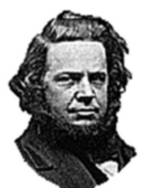

Elias Howe
Born: July 9, 1819
Place: Spencer, Massachusetts
Died: October 3, 1867
Place: Brooklyn, New York
 Elias Howe was born in Spencer, Massachusetts on July 9, 1819. His family had a small farm and a gristmill, and Elias spent much of his youth helping his father with farm chores and with the mill. He attended local schools in the winter months, but did not continue his education past the local grade school. When he was 16, he was hired at a local textile mill as a machinist's apprentice, and then he moved to Lowell, Massachusetts to work as a machinist in the Lowell mills. He married in 1841 and fathered three children.
Elias Howe was born in Spencer, Massachusetts on July 9, 1819. His family had a small farm and a gristmill, and Elias spent much of his youth helping his father with farm chores and with the mill. He attended local schools in the winter months, but did not continue his education past the local grade school. When he was 16, he was hired at a local textile mill as a machinist's apprentice, and then he moved to Lowell, Massachusetts to work as a machinist in the Lowell mills. He married in 1841 and fathered three children.
Machinery was always interesting to Howe, and his time in the textile mills set Howe to think about a machine that would be able to automate the process of sewing. He came up with a design that used a needle with an eye at its sharp point to push thread through cloth, forming a loop that allowed a threaded arm to move through the loop and pull it tight to create a lock stitch. He created his first successful sewing machine in 1845, and obtained a patent the following year. However, Howe was a better inventor than salesman, and his machine did not catch on immediately. Receiving poor response in the United States, Howe decided that England might be the place to sell his machines. Unfortunately, Howe's machine sales did not fare well in England, either, and to make matters worse, his patented design began to be imitated on both sides of the ocean. With little money, he initiated lawsuits to try to get his patent for the sewing machine upheld. Manufacturers began producing sewing machines using his design, but he was not being compensated for what he saw as his rightful patent on the design of the sewing machine.
Finally, in 1854, his lawsuits were successful, and Elias Howe was recognized as the rightful owner of the patented design. From this point on, Howe began to receive royalties on every machine produced in the United States, and other manufacturers, including Isaac Singer, were required to pay Howe the royalties that were due him. Howe became a wealthy man after his impoverished beginnings. When the Civil War erupted, Howe joined as a member of the 17th Connecticut Volunteers. After serving, he moved to Bridgeport, Connecticut and established his own sewing machine plant there. Elias Howe, inventor of the sewing machine, died in 1867 in Brooklyn, New York.
|




